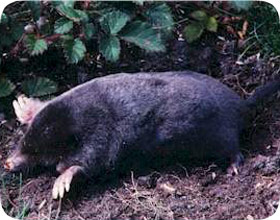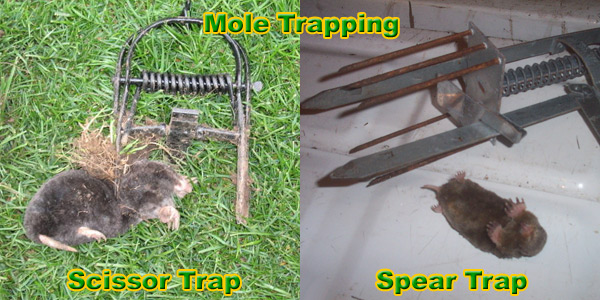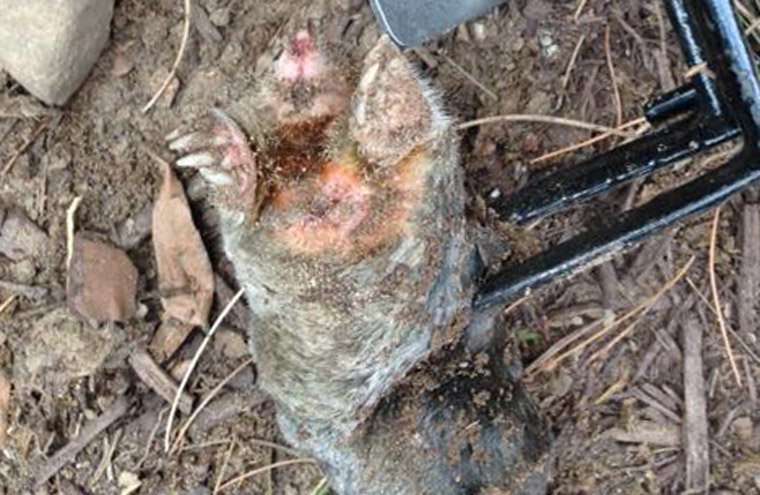- info@wildlife-removal.com
Call us for help in your town
Wildlife Removal Education
How to Trap a Mole - Trapping Tips
Need mole removal in your hometown? We service over 500 USA locations! Click here to hire us in your town and check prices - updated for year 2020.
 Mole Trapping Tips -
Many times when we want to rid ourselves of one pest or another it is because they are within our home and cause either damage or disgust, or both. Moles do not fall into that category. They do not harm us physically nor have they been known to spread disease.
However, since moles live on a diet of worms and grubs, they can do much unsightly damage to your lawn and garden. If you have spent a fair amount of money to have someone care for your lawn, then you certainly do not want unsightly lines disturbing the smooth grassy surface. If you have done your own work to have a showcase of flowers and other plants, then the destructive forces of moles can be nothing short of irritating. The way to get rid of pesky moles is by trapping them.
Mole Trapping Tips -
Many times when we want to rid ourselves of one pest or another it is because they are within our home and cause either damage or disgust, or both. Moles do not fall into that category. They do not harm us physically nor have they been known to spread disease.
However, since moles live on a diet of worms and grubs, they can do much unsightly damage to your lawn and garden. If you have spent a fair amount of money to have someone care for your lawn, then you certainly do not want unsightly lines disturbing the smooth grassy surface. If you have done your own work to have a showcase of flowers and other plants, then the destructive forces of moles can be nothing short of irritating. The way to get rid of pesky moles is by trapping them.
Click here for a nationwide list of 100's of professional mole trappers serving all 50 states.
First off, I have to point out that there is no such thing as a live catch mole trap. These animals dig underground, and no one has yet developed a trap that can effectively
catch them alive underground. Thus, all mole traps currently sold are lethal traps that kill moles. How to Kill Moles. There are three major types of mole traps:
Spear Traps - These are set on top of an active surface tunnel. Squish the tunnel down, and set the spear trap on top, with a trigger pan against the dirt. When the mole crawls through the tunnel, it will push open the squished down area, and this will
push up the trigger pan, causing the spears to slam downward, impaling the mole and killing it.
Scissor Traps - These traps are set over an active surface tunnel, with the scissor blades in the ground, on each side of the tunnel. When the mole crawls through the tunnel again, it triggers the trap, and the blades snap together, killing the mole.
Paper Clip Traps - These are actually set down inside the tunnel, often back to back, each facing outward. When the mole crawls through the tunnel as usual, coming from either direction, it will hit a pin holding the paper clip trap open, causing the pin to slip and the trap
to slam shut on the mole, killing it.
Finding the right mole tunnels to set the traps on is imperative. The more active, the better. Straight tunnels, or ones against edges (like a house or sidewalk) are a good bet for repeated use. The branching, winding tunnels that stretch out to nowhere might just be
one-time use feeding tunnels, and thus not heavily travelled and not as productive for trapping. It is not effective to set on top of mole hills. Read more about What is a mole hill?

What Is Another Reason For Wanting To Get Rid Of Moles?
Getting rid of moles may save you an ankle or a toe. The tunnels those little creatures dig, with admirable precision, leave loose dirt on the ground and a hollow tunnel underneath. If you are not careful where you step, you may step into one such tunnel and twist or sprain your ankle. If that isn’t enough to want them to leave your lawn, then the dead flowers you just planted may be the clincher.
What Do We Need To Know When Getting Rid Of Moles?
There are several rules to observe for successful mole trapping. It is important to have traps that are without scent. New traps may be best although you can work with old traps if you clean them thoroughly, expose them to the elements for a few days, then bury them in dirt, also for a few days before you use them. Rub dirt all over your hands before touching the trap. Any critter that can smell a worm can surely smell the scent of human hands.
Other Ideas To Consider When Catching Moles
You need to find the mole’s center “parlor,” from which it digs its additional tunnels outward, like the spokes of a wheel. That’s where the trap will be the most effective. The way to find this central tunnel is to follow the dirt mounds the mole leaves on the lawn. With a little detective work of looking, touching, maybe smelling, you will learn which mound is the freshest.
The mounds are the mole’s exit as well as the dumping place for the excavated dirt. If you dig carefully around a mound, maybe up to as much as a foot away, you will probably find the main tunnel. A long stick may also aid you in this determination. Carefully probe the ground in short intervals all the way around the mound until you feel less resistance. That will be the area for your trap.
How Should The Trap Be Placed?
The trap should be placed directly into the tunnel and pushed a little into the ground for stability. Make sure that there is no extra room on either side of the trap where the mole could slip by. Fill any extra space in with dirt. To keep the trap from being displaced by the mole, put a piece of wood on top and cover everything with dirt or sod. It is important to cover everything so that pets or other animals which may come to investigate will not be injured.
What’s Next?
With any luck at all, you will have a mole in your trap the next day. Traps should be checked every day. If no moles are trapped in several days, it may be a good idea to move the trap to a different location and the search for the tunnel begins again. It sounds time consuming but it really isn’t. It just takes a little patience. Sooner or later you will be successful and your lawn will once again be the pride of the neighborhood.
How to Trap A Mole
Moles are quite cool creatures when you think about they. They have many positives, despite being such a nuisance species. As well as airing out the soil, they also work as a natural hoeing system, allowing hydration and nourishment to get to deeper parts of the earth. They also eat their fair share of earthworms too, which does you a bit of a favor. Earthworms and other insects are often what draws other nuisance wildlife closer too, especially when food is scarce.

Of course, their mole hills and tunnels are the biggest concern. These tunnels, usually about twelve inches below the surface, can extend over vast distances. Moles live for three or four years in good conditions, and they can carry on extending their vast tunnel systems for the entire duration of this time. They will start by building the basic structure, or moving in to an abandoned existing tunnel system, and then get to work on it, creating areas to sleep and store food, and mothers will have special chambers that she will create into a nest once mating has taken place. The longer the mole is left there, the more tunnels it will create. This can obviously cause surface instability, and may result in some nasty injuries if an animal or person were to fall through into the tunnel. If these tunnels were to extend underneath a building, the building itself could be deemed structurally unsafe. It is definitely easier and better to prevent a mole from coming onto your land than it is to remove one that has already moved in.
Mole Trapping
Trapping moles is one way of dealing with the problem, and it’s a popular method too. There are a lot of traps on the market, some humane, others not so. A lot of technological advances have gone into these traps over recent years, with nuisance wildlife becoming an ever-growing problem. Traps are now safer than they were before, and easier to use. There are still a lot of disadvantages that you must bear in mind before using them, but the fact that they are safer, simpler, and more humane definitely helps to make things run a little smoother.
Types of Mole Traps
There are o many different trap on the market now, and the internet has made buying them so much easier. The trouble with that is that you can have too much choice, and when you are giving too many options, making the right one is a much harder task.
There are a few things that you will need to look at when picking out a mole trap:
1 - Is the trap cost-effective?
If the trap itself is going to cost more than what it would have cost to hire in a professional to do the entire job, there's a good chance the professional is the safer bet. When trapping, you don't just need to focus on the trapping and removal to get the job done. You must remove those tunnels that have been created by the animal, as well as sealing off your land to make sure the animal (and others like it) can't come back and start eh problem off all over again. If you're spending a couple of hundred dollars on traps and other pieces of equipment to get this job done, we'd recommend giving the experts a call. Many of them will offer a free quote, and can even give you advise and information on the law to make your job easier.
2 - Is the trap safe?
The trap should be safe for you AND the mole. If you are looking at a humane method of attack, killing or injuring the animal isn't the desired outcome. Do not buy a cheap trap from a friend because they’ve had great success with it. You don't know what state the trap will be in, or well it will run. You should always make sure you read the instructions too, and one that your mate has given you probably won't come with instructions. Traps can be very dangerous, not just to you and your poor fingers as you're trying to set it, but also to other animals. An incorrectly set or baited trap could attract the wrong animal.
3 - Is the trap chemical free?
You should avoid using any chemicals in the removal of moles, and this includes poisons too. This makes your job a lot harder, presenting you with dead carcasses that you must find and remove before they have the chance to attract other scavengers and opportunistic hunters. You will also run the risk of poisoning other wild animals, and domesticated pets too. Chemicals and poisons are incredibly dangerous and should not be used as a form of nuisance wildlife removal.
4 - What kind of trap do you want?
There are both kill traps and live cage traps that you could look at, but if you are going down the kill route, you will need to law at the legalities of doing so. If you accidentally capture of kill an animal that is protected at a state of federal level, or you target an animal that you are not allowed to target, you could be faced with legal proceedings. In fact, there are laws and regulations surrounding almost all aspects of nuisance wildlife removal and we highly recommend that you do your research before taking any action.
How to Use Mole Traps
Traps will need to be placed in active tunnels. The tunnels that are closer to the surface are generally temporary. The most-used tunnels will be much deeper, around 30 cm or so underground.
Traps placed in tunnels that are not used will not catch anything. Incorrectly placed traps will result in injury when you perhaps weren’t looking for that outcome. Live cage traps will also provide you with a problem — what are you going to do with the mole once you have captured it? Can you be sure that this mole isn't a female? If it is, you could have a mole nest in the underground tunnels and removing the mother alone will not solve the problem. You are then likely to have dead moles in a nest underground somewhere, and you won't be able to find it until another scavenger has moved in and dug it up. Nuisance wildlife will attract other nuisance wildlife, dead or alive.
We do not recommend using mole traps, or trying to remove moles at all, if you have not done your research. There are many traps on the market, each with their own advantages and disadvantages, and you will need to make sure that you are using the safest and best trap for you and your property. If you have a large surface area to protect, you may need to buy more than one trap. In a case like this, hiring in the professional to remove the moles, seal up the tunnels, and then make sure the problem doesn't come back will be the most cost effective solution.
Go back to the Mole Removal page, or learn tips to do it yourself with my How to Get Rid of Moles guide.


















